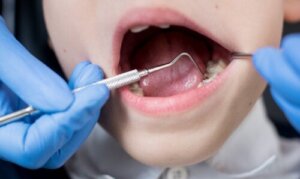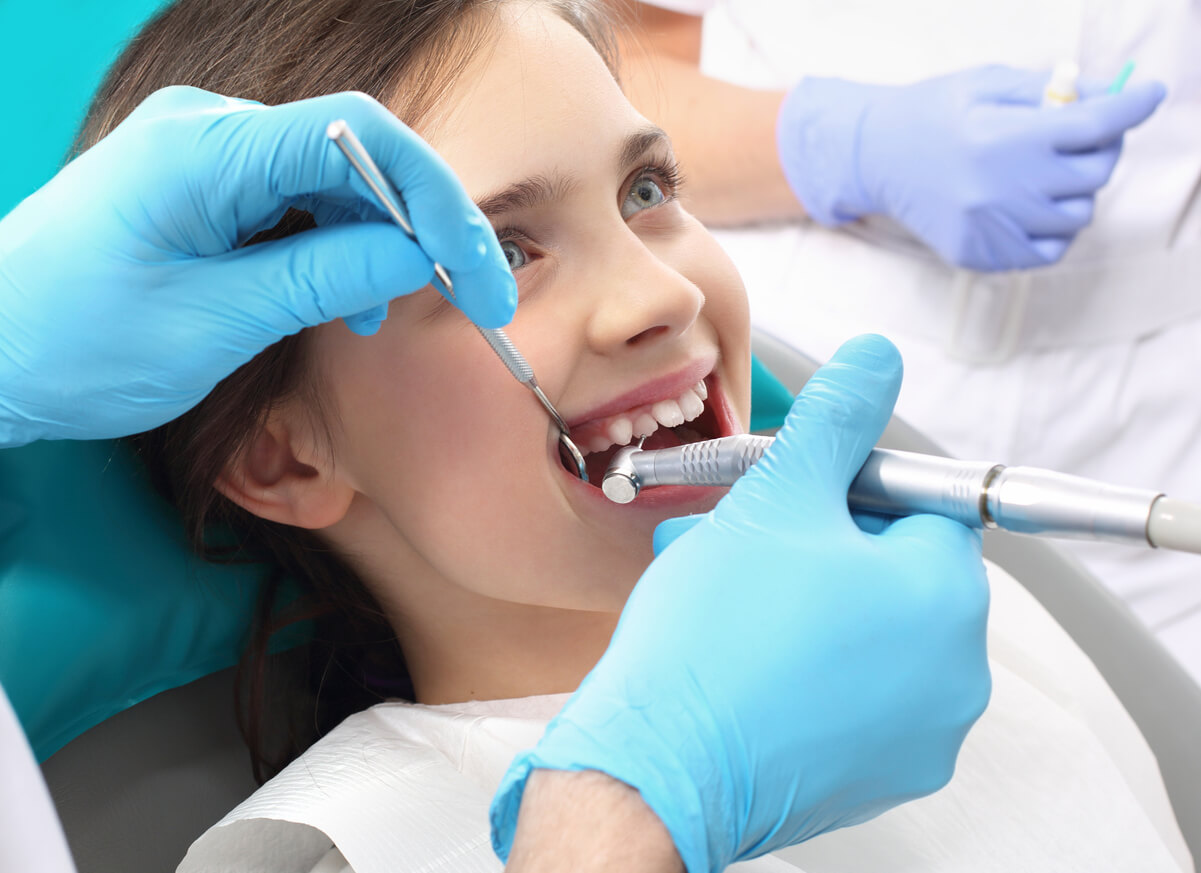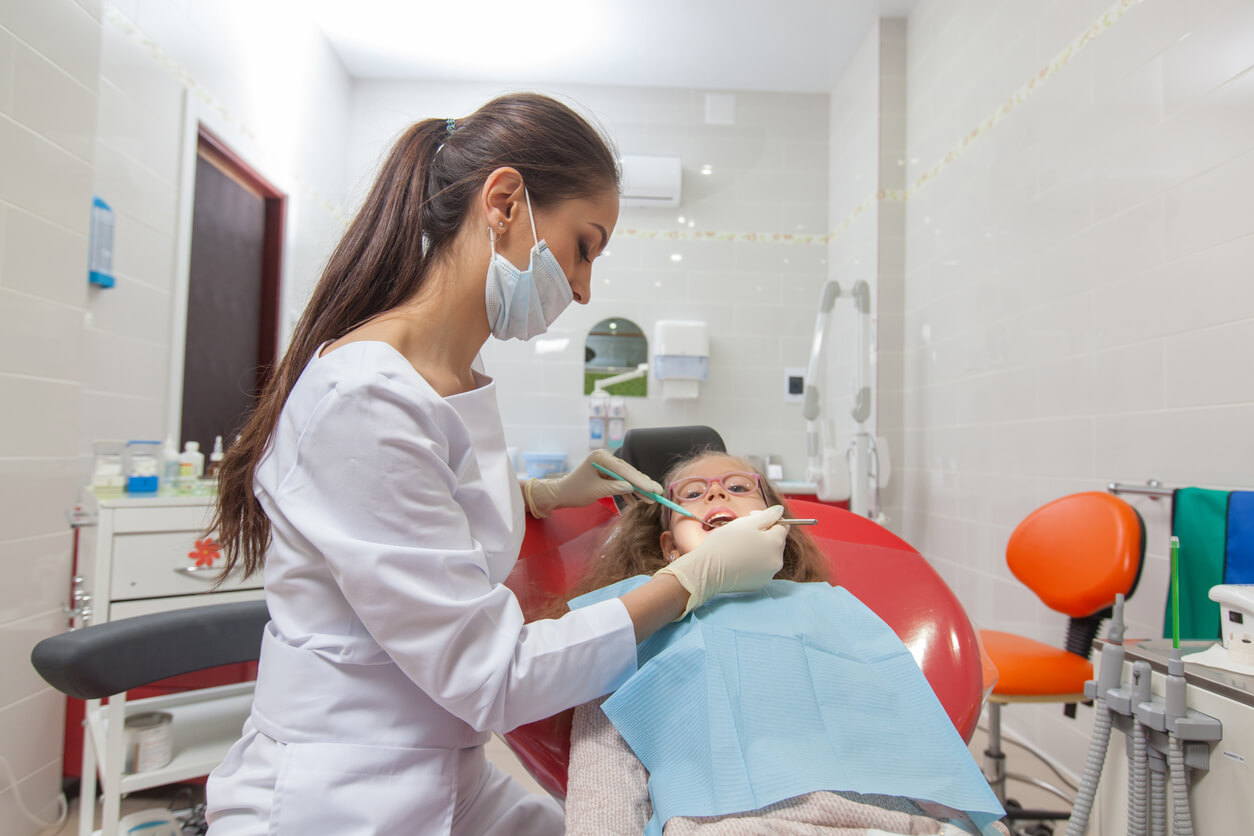The 6 Most Common Dental Treatments for Children


Written and verified by the dentist Vanesa Evangelina Buffa
Pediatric dentists play a fundamental role in maintaining the oral health of children. There are certain dental treatments that are performed more frequently in children, and here we’ll tell you about them.
Pediatric dentistry is the branch of dentistry that deals with the oral and dental care and attention of children, from the time they’re babies until adolescence. In this period, there are certain practices and procedures that are routinely performed, either to restore health or to prevent diseases.
In order for little ones to enjoy a healthy mouth and teeth, it’s important to take care of them from the earliest stages of growth. Discover the 6 most common dental treatments for children.
Learn about the most common dental treatments for children
Pediatric dentistry consultations are different from those for adults. When it comes to tending to children, times are slower, and patience and respect are essential in order to achieve an affectionate and trusting relationship between the child and the professional. According to the American Dental Association (ADA), checkups for children should begin before their first birthday. After that, they should be checked every 4 or 6 months, as indicated by the professional.
In pediatric dentistry consultations, the dentist checks the mouth of the little ones, controls the eruption of teeth, and evaluates the growth of the jaws. If they detect any alteration or a factor that puts the health of the mouth at risk, they’ll take the appropriate measures. Most of the treatments are aimed at preventing conditions such as cavities and malocclusions.
As a complement to the procedures, one of the main functions of pediatric dentists is to educate parents and children about mouth care. According to a bibliographic search published in the bulletin of the Catalan Society of Pediatrics, good oral habits from an early age help prevent prevalent oral pathologies. Below, we’ll tell you about the most frequent treatments.

1. Pit, groove, and fissure sealants
Evidence shows that fissure sealants are one of the most common dental treatments in children. With this procedure, it’s possible to prevent cavities in permanent teeth as soon as they erupt. However, they can also be applied to temporary teeth of children at high risk of developing the disease. Sealants consist of filling the irregularities of the occlusal surfaces of the teeth with a special material.
2. The application of fluoride
The use of fluoride in the dental office is one of the most widely used preventive measures against cavities in children’s dentistry. The application of this mineral strengthens the enamel and makes it more resistant to the action of acids produced by oral bacteria. In addition, it research has demonstrated that fluoride is capable of remineralizing the enamel and reversing the initial stages of cavities.
The application of fluoride in the dental office is simple, painless, and comfortable for patients. There are different presentations, such as gels, varnishes, lacquers, and liquids, such as rinses or silver diamine fluoride.
3. Dental cleaning
Dental prophylaxis or professional dental cleaning is a treatment performed by the pediatric dentist to eliminate the accumulation of bacterial plaque, tartar, and stains on tooth surfaces. With this procedure, it’s possible to remove the residues in the mouth that brushing and flossing fail to remove.
In general, dental prophylaxis in children is performed with ultrasound, brushes, and special abrasive pastes. In some cases, however, curettes can also be used to manually scrape the tooth surface and remove tartar. This results in smooth and shiny tooth surfaces that are pleasant to the touch.
4. Fillings
Fillings are mainly used to treat cavities. Although they can also solve the loss of dental tissue caused by a dental fracture or anomalies such as hypoplasias. There are different materials to make them: Composite resins, vitreous ionomers, and amalgams, although the latter have fallen into disuse because they contain mercury in their composition.
When teeth are badly destroyed and fillings aren’t enough to restore them, dental crowns are an excellent alternative. These caps cover the visible portion of the teeth so that they recover their appearance and function.

5. Endodontics for children
Endodontics is another dental treatment that’s frequently performed on children. This therapy makes it possible to resolve diseases of the dental pulp. In this way, it’s possible to keep the teeth in the mouth and avoid their extraction.
The pulp is the soft tissue found in the innermost part of the teeth. It contains blood vessels, nerve endings, and specialized cells. According to an observational study published by the Universidad Cooperativa de Colombia, this area of the tooth can be affected by very deep cavities, trauma, or as a consequence of certain dental treatments.
6. Children’s orthodontics
The placement of orthodontic appliances in children helps to correct defects in the development of the jaws and improper positioning of the teeth. They can treat occlusion alterations such as open bites, crossbites, overbites, narrow palates, alignment disorders, crowding, and diastemas. They also serve to correct dysfunctional habits such as oral breathing, thumb sucking, or atypical swallowing.
Acting as soon as the problem begins prevents malocclusions from progressing and becoming more complicated. This way, treatments are faster and more efficient, comfortable, and economical. For this reason, it’s essential to take children for regular check-ups and to start check-ups with an orthodontist from the age of 6. In general terms, two main types of treatment can be distinguished according to the child’s age:
- Interceptive orthodontics: This is used at early ages, before the age of 12. It’s used to solve alterations in the jaws when they’re still growing.
- Corrective orthodontics: This is performed when the dental replacement is finished, around the age of 12. With these treatments, the teeth are guided to their proper position. This type of approach includes the classic fixed braces with braces and also the new invisible aligner systems, such as Invisalign.
Preventive dentistry treatments for children are best
Of the dentistry treatments for children that we’ve told you about, those applied to prevent diseases are simpler, more comfortable, and more economical. In addition, they allow you to keep the mouth healthy and avoid complications and pain in your little one.
Regular check-ups are a great opportunity for pediatric dentists to perform them when necessary. In addition, they’re essential to maintaining the oral health status achieved with previous treatments. Don’t put off dental care for your little ones and take them to the dentist on a regular basis.
Pediatric dentists play a fundamental role in maintaining the oral health of children. There are certain dental treatments that are performed more frequently in children, and here we’ll tell you about them.
Pediatric dentistry is the branch of dentistry that deals with the oral and dental care and attention of children, from the time they’re babies until adolescence. In this period, there are certain practices and procedures that are routinely performed, either to restore health or to prevent diseases.
In order for little ones to enjoy a healthy mouth and teeth, it’s important to take care of them from the earliest stages of growth. Discover the 6 most common dental treatments for children.
Learn about the most common dental treatments for children
Pediatric dentistry consultations are different from those for adults. When it comes to tending to children, times are slower, and patience and respect are essential in order to achieve an affectionate and trusting relationship between the child and the professional. According to the American Dental Association (ADA), checkups for children should begin before their first birthday. After that, they should be checked every 4 or 6 months, as indicated by the professional.
In pediatric dentistry consultations, the dentist checks the mouth of the little ones, controls the eruption of teeth, and evaluates the growth of the jaws. If they detect any alteration or a factor that puts the health of the mouth at risk, they’ll take the appropriate measures. Most of the treatments are aimed at preventing conditions such as cavities and malocclusions.
As a complement to the procedures, one of the main functions of pediatric dentists is to educate parents and children about mouth care. According to a bibliographic search published in the bulletin of the Catalan Society of Pediatrics, good oral habits from an early age help prevent prevalent oral pathologies. Below, we’ll tell you about the most frequent treatments.

1. Pit, groove, and fissure sealants
Evidence shows that fissure sealants are one of the most common dental treatments in children. With this procedure, it’s possible to prevent cavities in permanent teeth as soon as they erupt. However, they can also be applied to temporary teeth of children at high risk of developing the disease. Sealants consist of filling the irregularities of the occlusal surfaces of the teeth with a special material.
2. The application of fluoride
The use of fluoride in the dental office is one of the most widely used preventive measures against cavities in children’s dentistry. The application of this mineral strengthens the enamel and makes it more resistant to the action of acids produced by oral bacteria. In addition, it research has demonstrated that fluoride is capable of remineralizing the enamel and reversing the initial stages of cavities.
The application of fluoride in the dental office is simple, painless, and comfortable for patients. There are different presentations, such as gels, varnishes, lacquers, and liquids, such as rinses or silver diamine fluoride.
3. Dental cleaning
Dental prophylaxis or professional dental cleaning is a treatment performed by the pediatric dentist to eliminate the accumulation of bacterial plaque, tartar, and stains on tooth surfaces. With this procedure, it’s possible to remove the residues in the mouth that brushing and flossing fail to remove.
In general, dental prophylaxis in children is performed with ultrasound, brushes, and special abrasive pastes. In some cases, however, curettes can also be used to manually scrape the tooth surface and remove tartar. This results in smooth and shiny tooth surfaces that are pleasant to the touch.
4. Fillings
Fillings are mainly used to treat cavities. Although they can also solve the loss of dental tissue caused by a dental fracture or anomalies such as hypoplasias. There are different materials to make them: Composite resins, vitreous ionomers, and amalgams, although the latter have fallen into disuse because they contain mercury in their composition.
When teeth are badly destroyed and fillings aren’t enough to restore them, dental crowns are an excellent alternative. These caps cover the visible portion of the teeth so that they recover their appearance and function.

5. Endodontics for children
Endodontics is another dental treatment that’s frequently performed on children. This therapy makes it possible to resolve diseases of the dental pulp. In this way, it’s possible to keep the teeth in the mouth and avoid their extraction.
The pulp is the soft tissue found in the innermost part of the teeth. It contains blood vessels, nerve endings, and specialized cells. According to an observational study published by the Universidad Cooperativa de Colombia, this area of the tooth can be affected by very deep cavities, trauma, or as a consequence of certain dental treatments.
6. Children’s orthodontics
The placement of orthodontic appliances in children helps to correct defects in the development of the jaws and improper positioning of the teeth. They can treat occlusion alterations such as open bites, crossbites, overbites, narrow palates, alignment disorders, crowding, and diastemas. They also serve to correct dysfunctional habits such as oral breathing, thumb sucking, or atypical swallowing.
Acting as soon as the problem begins prevents malocclusions from progressing and becoming more complicated. This way, treatments are faster and more efficient, comfortable, and economical. For this reason, it’s essential to take children for regular check-ups and to start check-ups with an orthodontist from the age of 6. In general terms, two main types of treatment can be distinguished according to the child’s age:
- Interceptive orthodontics: This is used at early ages, before the age of 12. It’s used to solve alterations in the jaws when they’re still growing.
- Corrective orthodontics: This is performed when the dental replacement is finished, around the age of 12. With these treatments, the teeth are guided to their proper position. This type of approach includes the classic fixed braces with braces and also the new invisible aligner systems, such as Invisalign.
Preventive dentistry treatments for children are best
Of the dentistry treatments for children that we’ve told you about, those applied to prevent diseases are simpler, more comfortable, and more economical. In addition, they allow you to keep the mouth healthy and avoid complications and pain in your little one.
Regular check-ups are a great opportunity for pediatric dentists to perform them when necessary. In addition, they’re essential to maintaining the oral health status achieved with previous treatments. Don’t put off dental care for your little ones and take them to the dentist on a regular basis.
All cited sources were thoroughly reviewed by our team to ensure their quality, reliability, currency, and validity. The bibliography of this article was considered reliable and of academic or scientific accuracy.
- American Dental Association (2023) Your Baby’s First Dental Visit. Consultado el 29 de Marzo de 2023. https://www.mouthhealthy.org/life-stages/babies-and-kids/first-dental-visit-for-baby
- Ampuero Calani, C. (2022). Odontopediatria. http://ddigital.umss.edu.bo:8080/jspui/handle/123456789/28120
- Argüello Vargas, S. (2015). Tratamientos dentales más comunes realizados en niños menores de 12 años en la CLÍNICA ULACIT, durante el periodo del 2014 al 2015. https://repositorio.ulacit.ac.cr/bitstream/handle/123456789/1081/046689.pdf?sequence=1
- Baik, A., Alamoudi, N., El-Housseiny, A., & Altuwirqi, A. (2021). Fluoride varnishes for preventing occlusal dental caries: A review. Dentistry journal, 9(6), 64. https://www.mdpi.com/2304-6767/9/6/64
- Boj, J. R., Cortés, O., Alonso, E., & Conde, S. (2019). Noves tendències preventives en odontopediatria. Pediatr. catalan, 83-88. https://pesquisa.bvsalud.org/portal/resource/esSiqueira/ibc-191071
- Díaz Mori, J. (2019). Tratamientos dentales basados en mínima intervención en Odontopediatría: revisión de la literatura. https://repositorio.cientifica.edu.pe/handle/20.500.12805/967
- Kooshki, F., Pajoohan, S., & Kamareh, S. (2019). Effects of treatment with three types of varnish remineralizing agents on the microhardness of demineralized enamel surface. Journal of clinical and experimental dentistry, 11(7), e630. https://www.ncbi.nlm.nih.gov/pmc/articles/PMC6731000/
- Vanegas Marentes, D., Solano Mejia, M. P., & Capera Castro, C. M. (2022). Frecuencia de pulpotomías y causas asociadas en pacientes de 3 a 8 años, que asistieron a clínica de niño en la universidad cooperativa de Colombia sede Bogotá durante los años 2018 y 2019. https://repository.ucc.edu.co/items/577ba46c-93fc-4aef-a365-48a497d1ca77
- Zou, J., Meng, M., Law, C. S., Rao, Y., & Zhou, X. (2018). Common dental diseases in children and malocclusion. International journal of oral science, 10(1), 7. https://www.nature.com/articles/s41368-018-0012-3
This text is provided for informational purposes only and does not replace consultation with a professional. If in doubt, consult your specialist.








